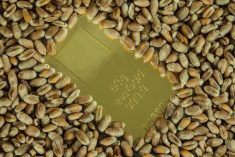Pop quiz: how are Tiger Woods and Canadian flax the same?
Yes, you got it: They both have huge image problems and buyers have fled.
We all know about Tiger’s troubles. It’d be hard not to know about them, considering it’s being talked about on the American media 23.5/7 and leaping out at us from supermarket tabloid front pages and being joked about by every TV talkshow host. When someone advertised by numerous advertisers as Mr. Wonderful ends up lying flat on the street after smacking his SUV into a fire hydrant and pole, and the sexy skeletons begin popping out of his closets and rattling their bones for all to see, it’s not hard to understand why the advertisers have yanked all their ads including the poor, suffering multi-millionaire fellow.
Read Also

Invigor Gold variety viewed as threat to condiment mustard
Invigor Gold, the canola-quality mustard developed by BASF, is on a collision course with Canada’s condiment mustard industry. It’s difficult to see how the two can co-exist.
According to a Bloomberg news story today, all the many TV ads featuring Woods’ face have disappeared since his troubles began. He’s been pulled from the shelves, so to speak. That’s a lot like Canadian flax, which has been banned from European shelves since that Triffid business began, and that well-paying and steady market has been put in jeopardy.
Farmers aren’t happy about this. I’m right now at a “Genetic Expo” conference in Winnipeg and farmers pointedly asked the head of the Canadian Grain Commission and a company testing for genetic modification in flax how people had gotten away with growing Triffid and whether they could be tracked down. The tester said that there is no evidence yet of where and why the Triffid contamination occurred and there may never be. Starbuck farmer Ed Rempel bitterly noted that “I don’t think anybody wants to find the farmer responsible.” The head of the commish pointed out that growing Triffid isn’t actually banned.
Is there a farmer knowingly responsible? There are opinions all over the map about that. A couple of farmers I spoke to this morning said the Triffid could have been spread by someone hanging onto a bagful of seed from almost a decade ago and mixing it in with their next year’s seed at the time. Or someone could have handed over the seed when it was deregistered, but swept the seeds that fell onto the floor up and into non-Triffid seed. Flax seeds are tiny and a couple of handfuls contain thousands of seeds that over a decade could multiply out into a lot if planted along with a seed crop. Perhaps, the tester said, it’s just a product of pollen in the wind.
Flax crops are now being tested across the prairies, and one of the growers I spoke to was pleased his crop had tested clean. There are rumours that Triffid-tainted seeds are mainly showing up in tests on crop from areas northwest of Saskatoon. But nothing public and definitive yet. But flax growers are intently watching for the problem area to be identified.
Will a knowing culprit ever be found? If he is, he’ll probably have to act like Tiger, and hide in his house and avoid the public’s accusing eyes. Growing Triffid on purpose would probably be as fun for a farmer to explain to other farmers as Tiger explaining to his wife who all these ladyfriends are.















